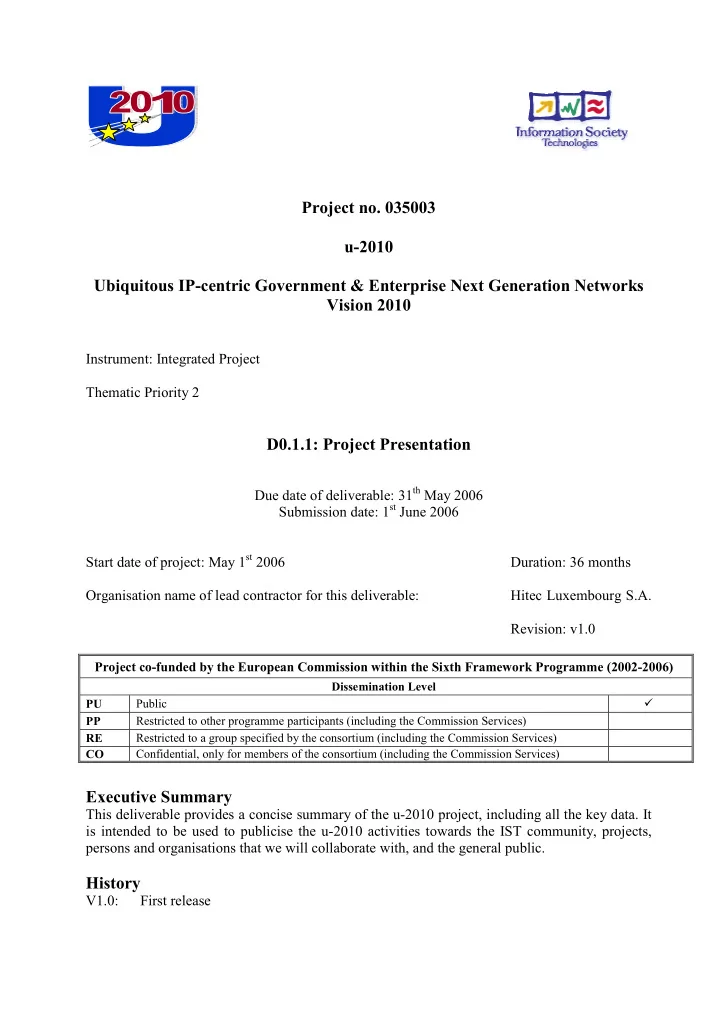

Project no. 035003 u-2010 Ubiquitous IP-centric Government & Enterprise Next Generation Networks Vision 2010 Instrument: Integrated Project Thematic Priority 2 D0.1.1: Project Presentation Due date of deliverable: 31 th May 2006 Submission date: 1 st June 2006 Start date of project: May 1 st 2006 Duration: 36 months Organisation name of lead contractor for this deliverable: Hitec Luxembourg S.A. Revision: v1.0 Project co-funded by the European Commission within the Sixth Framework Programme (2002-2006) Dissemination Level PU Public � PP Restricted to other programme participants (including the Commission Services) RE Restricted to a group specified by the consortium (including the Commission Services) CO Confidential, only for members of the consortium (including the Commission Services) Executive Summary This deliverable provides a concise summary of the u-2010 project, including all the key data. It is intended to be used to publicise the u-2010 activities towards the IST community, projects, persons and organisations that we will collaborate with, and the general public. History V1.0: First release
u-2010 Ubiquitous IP-centric Government & Enterprise Next Generation Networks Vision 2010 Vision Provide the most capable means of communication and the most effective access to information to everybody required to act in case of accident, incident, catastrophe or crisis, while using existing or future telecommunication infrastructure Abstract Modern society has reached a high dependability on ubiquitous services and networks. Especially in crisis or emergency situations the availability of these services is crucial. Today, governmental and rescue entity communication services are characterized by a strong technical compartmentalization; the interworking and availability of crisis communication resources is not assured. This project highlights and deploys concepts to enhance the availability of these services and the existing networks by leveraging redundant communication channels wherever possible and using automatic redirection in the case of network failures. In crisis situations, rescue teams have to be assembled fast and flexibly; mobile and ad-hoc networks are one possible solution. Additional research on these networks will be conducted in this project to fulfil the requirements of crisis intervention teams. The problem of identification will be resolved using new research results in wireless and ad-hoc networks, where especially the integration of distributed knowledge of the current network environment (location information, RFID messages, recommended trust relations, etc.) into the protocols is a key issue for context adaptable recognition. The project will take advantage of IPv6 features for many of the ICT aspects related to crisis scenarios. With Luxembourg as the first test bed and the Luxembourg Government as a partner in the project, there is IST Integrated Project – u-2010 an ideal possibility to show the feasibility and usability of the results in a real environment and provide the basis for all European countries. A transfer of the technology through a deployment in Slovenia is planned in the second phase of the project. The results of this project will be usable not only for governments risk- and crisis- management but will also become an integral part of enterprise and public networks, thereby fulfilling our Next Generation Network vision for ubiquitous networks in 2010 - “u-2010”. Objectives The measurable and verifiable S&T objectives of the u-2010 project are: - To perform the requirements analysis for increasing the availability, QoS and security of a collection of services and networks. - To identify the necessary measures and concepts to “bridge” between the different networks/services on the basis of a Next Generation Network Protocol (starting with IPv6). - To define (one ore more) reference scenarios of needed networks and application-bridging technologies. - To define and implement a prototype infrastructure including (governmental and industrial) service providers and users as well as performance tests for a quantitative evaluation of the results. This could later serve as a European test bed for interested third parties not participating in the project. - Deploy management tools to control the quality of service, security and availability of the collection of services and networks defined. - Contribute actively in the appropriate standards activities to influence the specification of standards that are important for the definition of this Critical Infrastructure Protection Network.
Recommend
More recommend